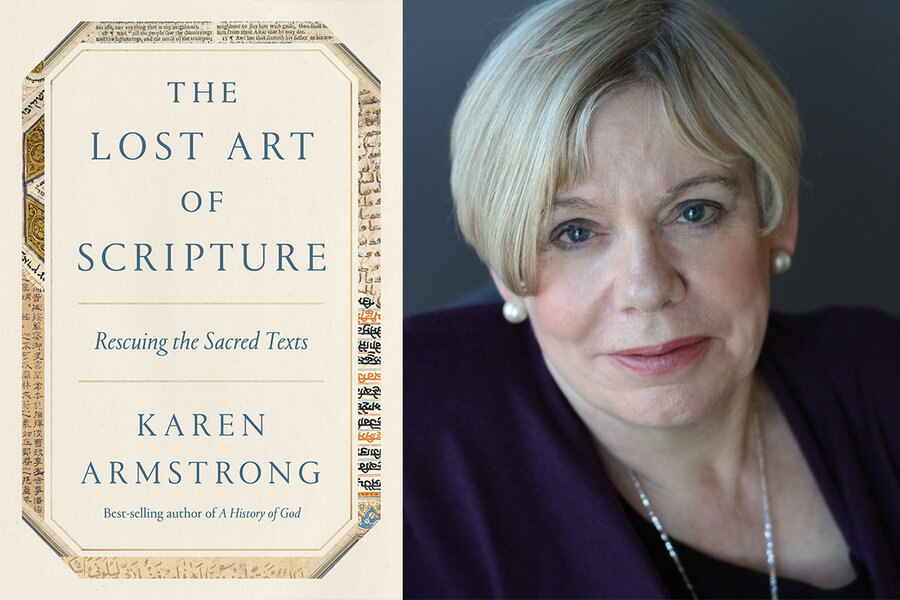Scripture as an art form? Q&A with Karen Armstrong.
Loading...
Karen Armstrong, a bestselling British scholar of religion and former Roman Catholic nun, says that faith has more than a role in modern society. It has a mandate to make the world a better place. A desire to do good, she believes, unites the major spiritual traditions. But how can we approach the guiding words of sacred texts? Should we only read books? That’s not the way the ancients approached it, Ms. Armstrong says. As she explained in an interview with the Monitor’s Randy Dotinga, “We must plumb our religious insights from our scriptures and let them speak to us today in new and innovative ways.”
What inspired your book?
I was initially intrigued by the idea that the Bible was essentially a performative art. It was always chanted, and our focus on the written word and silent reading means that we’re appreciating it differently. As I developed my research, I was surprised at the very different way that people experienced the scriptures in the premodern world. I realized that in many ways scripture is an art form, but we no longer really know how to approach it.
Why We Wrote This
Studying a holy text can become a habitual task instead of a mindful exercise. So when religion scholar Karen Armstrong discovered that the Bible was originally performed as a chant, she was inspired to rethink her understanding of the spiritual imagination – and what that means for the daily practice of faith.
Is reading sacred texts – and only reading them – akin to only reading the plays of Shakespeare?
Yes. Today, Western people often tell me that they’ve read the Quran. You don’t read it. You listen to it or you recite it. Quran means “recite.” Recitation is an art form, and people will congregate in huge crowds to hear a famous Quran reciter. It’s immensely moving.
This has always been the case in faith. Scripture was a performative art, such as the intensely emotional and argumentative art of Jewish midrash. They weren’t meekly reading their Bibles silently. There’s also a spiritual experience of imagination. The Talmud says every time a Jew and his teacher argue together, they must imagine themselves standing on Mount Sinai with Moses. Revelation will come to them.
What do we miss about the meaning of sacred writings?
You have to take the art form in its genre. You’re not expecting facts from a novel. They’re not historical records, and we’re not horrified to hear that Mr. Darcy in “Pride and Prejudice” never existed. Instead, they’re telling us truths about the human condition.
When we take a factual approach to scripture, we’re reading it in a very strange way. It isn’t telling us truths about God. The concept of nirvana in Buddhism, for example, cannot be summed up neatly in human language. It’s transcendent.
How can sacred texts help people reach transcendence?
Consider the Gregorian chant, which is extremely demanding, more so than [the hymn] “Onward Christian Soldiers.” It’s very exacting. Monks would be getting up at 1 in the morning to sing the psalms. Exhausted and immersed in this difficult thing, they left themselves behind. They were just one with the text, getting rid of the ego, the “I,” the “me.”
If you immerse yourself in the sound of the scripture, in the singing of it, you have left yourself behind. That’s the kind of truth that an Indian person reaches when they recite a mantra.
How can people of faith recapture the experience of sacred texts?
We can’t do that anymore than Martin Luther could go back to the first century. It’s hard to just create performative art out of the blue.
Perhaps it’s better to start with the whole idea of how we can translate scripture into practical action for our broken world: What can we do?
Scripture is not “all about me, my salvation,” which we’ve gotten rather hooked on: It often seems to all be about how we get into heaven, and Jesus sounds like a personal trainer instead of this dynamic figure in the Gospels, an explosive character who is endlessly pushing forward, going out and meeting suffering and pain.
We forget we have this imperative to go out and heal the world.
Go forth, as the Buddha said to the monks, and travel to heal the suffering in the world. We have to open our hearts.





